

Linked Data: Moving Towards Consumption. Earlier this month 16 out of 42 papers were accepted for the upcoming Linked Data on the Web (LDOW) 2012 Workshop in Lyon, France in April.

What might be discerned from the tenor of the submissions is something of a shift in focus in the Linked Data space, according to workshop chair Dr. Michael Hausenblas, Linked Data Research Centre, DERI, NUI Galway, Ireland. Other organizing committee members include Tim Berners-Lee, Christian Bizer and Tom Heath. Faceted Wikipedia Search. ProgrammableWeb - Mashups, APIs, and the Web as Platform.
Thinkmap SDK. The Thinkmap SDK enables organizations to incorporate data-driven visualization technology into their enterprise Web applications.
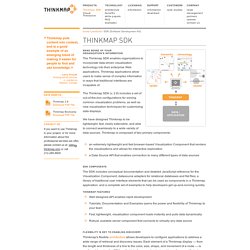
Thinkmap applications allow users to make sense of complex information in ways that traditional interfaces are incapable of. The Thinkmap SDK (v. 2.8) includes a set of out-of-the-box configurations for solving common visualization problems, as well as new visualization techniques for customizing data displays. We have designed Thinkmap to be lightweight, fast, easily extensible, and able to connect seamlessly to a wide variety of data sources.
Maltego 3 > Community Edition. Software Packages for Graphical Models / Bayesian Networks. NetSeer Pushes Concepts, Not Keywords, for Contextual Targeting. Written on Aug 11, 2011 Author.

New York Times - Linked Open Data. Exhibit 3.0 Project. Getting Involved Join us on IRC on freenode or browse the SIMILE Widgets mailing list archives to ask questions about Exhibit.

Chances are others may have similar questions, and the list is a great place to share answers. Background The Exhibit 3 project was supported by the Library of Congress. It is a partnership among MIT Libraries, MIT CSAIL and Zepheira, including personnel from the original SIMILE project. Thomas Neumann: D5: Databases and Information Systems (Max-Planck-Institut für Informatik) Tetherless World Demos. Home. Schema.org. Most webmasters are familiar with HTML tags on their pages.

Usually, HTML tags tell the browser how to display the information included in the tag. For example, <h1>Avatar</h1> tells the browser to display the text string "Avatar" in a heading 1 format. However, the HTML tag doesn't give any information about what that text string means—"Avatar" could refer to the hugely successful 3D movie, or it could refer to a type of profile picture—and this can make it more difficult for search engines to intelligently display relevant content to a user.
Schema.org provides a collection of shared vocabularies webmasters can use to mark up their pages in ways that can be understood by the major search engines: Google, Microsoft, Yandex and Yahoo! 1. 1a. How Schema.org Will Change Your Search Results & What it Means for Marketers. Jeff Ente is the director of Who's Blogging What, a weekly e-newsletter that tracks over 1,100 social media, web marketing and user experience blogs to keep readers informed about key developments in their field and highlight useful but hard to find posts.
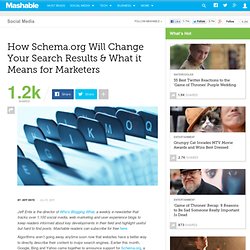
Mashable readers can subscribe for free here. Algorithms aren’t going away anytime soon now that websites have a better way to directly describe their content to major search engines. Earlier this month, Google, Bing and Yahoo came together to announce support for Schema.org, a semantic markup protocol with its own vocabulary that could provide websites with valuable search exposure. Nothing will change overnight, but Schema.org is important enough to bring the three search giants together. Ontology Instances. Welcome to OneSource - OneSource. SIMILE: Practical Metadata for the Semantic Web - Ésta es una idea de Google Docs. Semantic tools. Why the Semantic Web Will Fail. Internet Semantic Web Web 3.0. Microformats vs. RDF: How Microformats Relate to the Semantic Web.
Update: Joe from the Squio blog has posted a response to this entry.
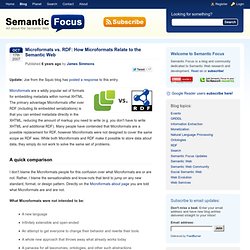
Microformat. A microformat (sometimes abbreviated μF) is a web-based approach to semantic markup which seeks to re-use existing HTML/XHTML tags to convey metadata[1] and other attributes in web pages and other contexts that support (X)HTML such as RSS.

This approach allows software to process information intended for end-users (such as contact information, geographic coordinates, calendar events, and similar information) automatically. Although the content of web pages is technically already capable of "automated processing", and has been since the inception of the web, such processing is difficult because the traditional markup tags used to display information on the web do not describe what the information means.[2] Microformats can bridge this gap by attaching semantics, and thereby obviate other, more complicated, methods of automated processing, such as natural language processing or screen scraping.
Background[edit] Neither CommerceNet nor Microformats.org operates as a standards body. Class rel. Microdata (HTML5) Microdata is a WHATWG HTML specification used to nest metadata within existing content on web pages.[1] Search engines, web crawlers, and browsers can extract and process Microdata from a web page and use it to provide a richer browsing experience for users.
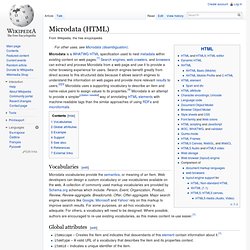
Search engines benefit greatly from direct access to this structured data because it allows search engines to understand the information on web pages and provide more relevant results to users.[2][3] Microdata uses a supporting vocabulary to describe an item and name-value pairs to assign values to its properties.[4] Microdata is an attempt to provide a simpler[citation needed] way of annotating HTML elements with machine-readable tags than the similar approaches of using RDFa and microformats.
Microdata vocabularies provide the semantics, or meaning of an Item. Open Mind. Common Sense Computing Initiative. ConceptNet aims to give computers access to common-sense knowledge , the kind of information that ordinary people know but usually leave unstated. The data in ConceptNet is being collected from ordinary people who contributed it on sites like Open Mind Common Sense . ConceptNet represents this data in the form of a semantic network, and makes it available to be used in natural language processing and intelligent user interfaces.
Ontology construction from text. Gellish. Gellish is a formal language that is natural language independent, although its concepts have 'names' and definitions in various natural languages.
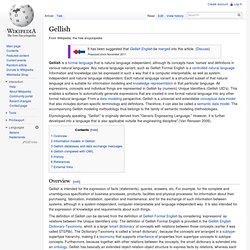
Any natural language variant, such as Gellish Formal English is a controlled natural language. Information and knowledge can be expressed in such a way that it is computer-interpretable, as well as system-independent and natural language independent. Each natural language variant is a structured subset of that natural language and is suitable for information modeling and knowledge representation in that particular language. Common Sense Computing Initiative. Years ago, we made a decision to put all our Python packages in a common namespace called csc . To put it simply, this did not work well. Today, we have finally undone this decision by deprecating the csc namespace and renaming every single one of our modules. Python programmers, please learn from our mistake and never make a namespace package. If you upgrade our software, you'll get more straightforward names for our modules. The new releases are ConceptNet 4.0.0 , Divisi2 2.2.0 , csc-utils 0.6 , and a new package called simplenlp 0.9 .
From Taxonomy to Ontology: Laying the GroundWork for the Semantic Web. Folksonomies - Cooperative Classification and Communication Through Shared Metadata. The Creation of Metadata: Professionals, Content Creators, Users Metadata is often characterized as “data about data.” Metadata is information, often highly structured, about documents, books, articles, photographs, or other items that is designed to support specific functions.
YAGO-NAGA - D5: Databases and Information Systems (Max-Planck-Institut für Informatik) Overview YAGO is a huge semantic knowledge base, derived from Wikipedia WordNet and GeoNames. Currently, YAGO has knowledge of more than 10 million entities (like persons, organizations, cities, etc.) and contains more than 120 million facts about these entities.
YAGO is special in several ways: The accuracy of YAGO has been manually evaluated, proving a confirmed accuracy of 95%. Demo of a Semantic Web Portal. Inc. - Semantic Web Technologies. Omeka. Associative model of data. XML Introduction - What is XML? Kif. RDF and Jena. RDF-Gravity. Sunil Goyal, Rupert Westenthaler {sgoyal, rwestenthaler}@salzburgresearch.at Salzburg Research, Austria RDF Gravity is a tool for visualising RDF/OWL Graphs/ ontologies. Its main features are: Graph VisualizationGlobal and Local Filters (enabling specific views on a graph) Full text SearchGenerating views from RDQL QueriesVisualising multiple RDF files RDF Gravity is implemented by using the JUNG Graph API and Jena semantic web toolkit.
Figure 1: Screenshot of RDF-Gravity, showing a part of Wine Ontology 1 Graph Visualisation RDF Gravity defines a visualization package on top of the JUNG Graph API. Configurable renderers for edges and nodes of a graph, including different node shapes and edge decorations etc.A Renderer Factory allowing the configuration of the above node and edge renderers based on the type of an edge or node. For graph layout, it uses the layout algorithms directly supported by the Jung API. 2 Global & Local Filters 3 Full Text Search 4 Visualising Multiple RDF Files. Why triples are not enough. OpenRDF.org: Home. Describing Copyright in RDF - Creative Commons Rights Expression Language. RDFa Basics. Using Dublin Core - The Elements. Primer - Getting into the semantic web and RDF using N3.
RDFa Primer. The Friend of a Friend (FOAF) project. RDF Vocabulary Description Language 1.0: RDF Schema. Abstract RDF Schema provides a data-modelling vocabulary for RDF data. RDF Schema is an extension of the basic RDF vocabulary. RDFa, Drupal and a Practical Semantic Web. Open Archives Initiative - Protocol for Metadata Harvesting - v.2.0. Editors The OAI Executive:Carl Lagoze <lagoze@cs.cornell.edu > -- Cornell University - Computer Science Herbert Van de Sompel <herbertv@lanl.gov > -- Los Alamos National Laboratory - Research Library. Open Archives Initiative Protocol for Metadata Harvesting. Cross-media: Controlling your Language: a Directory of Metadata Vocabularies. How to publish Linked Data on the Web.
The Linking Open Data cloud diagram. SweoIG/TaskForces/CommunityProjects/LinkingOpenData - ESW Wiki. News. Linked Data - Connect Distributed Data across the Web.